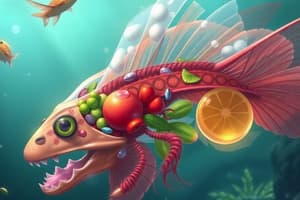Podcast
Questions and Answers
What is the process by which animals obtain and utilize nutrients from their diet?
What is the process by which animals obtain and utilize nutrients from their diet?
- Digestion
- Nutrition (correct)
- Respiration
- Photosynthesis
What type of nutrition involves consuming other organisms or organic matter?
What type of nutrition involves consuming other organisms or organic matter?
- Heterotrophy (correct)
- Symbiotic Nutrition
- Macronutrition
- Autotrophy
What is the site of initial food breakdown in the digestive system?
What is the site of initial food breakdown in the digestive system?
- Mouth and Pharynx (correct)
- Small Intestine
- Large Intestine
- Esophagus and Stomach
Where does most nutrient absorption occur?
Where does most nutrient absorption occur?
What is the role of the large intestine?
What is the role of the large intestine?
What is the result of carbohydrate metabolism?
What is the result of carbohydrate metabolism?
What is the role of gastric juices and enzymes in the stomach?
What is the role of gastric juices and enzymes in the stomach?
What type of nutrition involves a mutually beneficial relationship between two organisms?
What type of nutrition involves a mutually beneficial relationship between two organisms?
Flashcards are hidden until you start studying
Study Notes
Nutrition in Animals
Overview
- Nutrition is the process by which animals obtain and utilize nutrients from their diet to sustain life and support growth, maintenance, and reproduction.
- Nutrients are classified into two categories: macronutrients (carbohydrates, proteins, and fats) and micronutrients (vitamins and minerals).
Types of Nutrition
Heterotrophy
- Heterotrophic animals obtain energy by consuming other organisms or organic matter.
- Examples: carnivores, omnivores, and decomposers.
Autotrophy
- Autotrophic animals produce their own food through photosynthesis or chemosynthesis.
- Examples: coral animals with zooxanthellae, some species of sea slugs.
Symbiotic Nutrition
- Symbiotic nutrition involves a mutually beneficial relationship between two organisms, where one organism provides nutrients to the other.
- Examples: coral-algae symbiosis, mycorrhizal fungi.
Nutrient Uptake and Digestion
Mouth and Pharynx
- Food intake and initial breakdown occur in the mouth and pharynx.
- Teeth, beaks, or other mouthparts facilitate food capture and processing.
Esophagus and Stomach
- Food is swallowed and passes through the esophagus into the stomach.
- Gastric juices and enzymes break down proteins and fats in the stomach.
Small and Large Intestine
- Partially digested food enters the small intestine, where most nutrient absorption occurs.
- The large intestine absorbs water and electrolytes, and stores and eliminates waste.
Nutrient Utilization
Carbohydrate Metabolism
- Carbohydrates are broken down into glucose, which is absorbed and utilized for energy or stored as glycogen.
Protein Metabolism
- Proteins are broken down into amino acids, which are used for growth, maintenance, and energy production.
Fat Metabolism
- Fats are broken down into fatty acids and glycerol, which are used for energy production or stored as adipose tissue.
Nutrient Deficiencies and Excesses
Deficiencies
- Insufficient nutrient intake can lead to deficiencies, causing impaired growth, maintenance, or reproduction.
- Examples: protein-energy malnutrition, vitamin deficiencies.
Excesses
- Excessive nutrient intake can lead to toxicity, causing harm or even death.
- Examples: vitamin toxicity, obesity.
Nutrition in Animals
- Nutrition is the process by which animals obtain and utilize nutrients from their diet to sustain life and support growth, maintenance, and reproduction.
Types of Nutrition
Heterotrophy
- Heterotrophic animals obtain energy by consuming other organisms or organic matter.
- Examples: carnivores, omnivores, and decomposers.
Autotrophy
- Autotrophic animals produce their own food through photosynthesis or chemosynthesis.
- Examples: coral animals with zooxanthellae, some species of sea slugs.
Symbiotic Nutrition
- Symbiotic nutrition involves a mutually beneficial relationship between two organisms, where one organism provides nutrients to the other.
- Examples: coral-algae symbiosis, mycorrhizal fungi.
Nutrient Uptake and Digestion
Mouth and Pharynx
- Food intake and initial breakdown occur in the mouth and pharynx.
- Teeth, beaks, or other mouthparts facilitate food capture and processing.
Esophagus and Stomach
- Food is swallowed and passes through the esophagus into the stomach.
- Gastric juices and enzymes break down proteins and fats in the stomach.
Small and Large Intestine
- Partially digested food enters the small intestine, where most nutrient absorption occurs.
- The large intestine absorbs water and electrolytes, and stores and eliminates waste.
Nutrient Utilization
Carbohydrate Metabolism
- Carbohydrates are broken down into glucose, which is absorbed and utilized for energy or stored as glycogen.
Protein Metabolism
- Proteins are broken down into amino acids, which are used for growth, maintenance, and energy production.
Fat Metabolism
- Fats are broken down into fatty acids and glycerol, which are used for energy production or stored as adipose tissue.
Nutrient Deficiencies and Excesses
Deficiencies
- Insufficient nutrient intake can lead to deficiencies, causing impaired growth, maintenance, or reproduction.
- Examples: protein-energy malnutrition, vitamin deficiencies.
Excesses
- Excessive nutrient intake can lead to toxicity, causing harm or even death.
- Examples: vitamin toxicity, obesity.
Studying That Suits You
Use AI to generate personalized quizzes and flashcards to suit your learning preferences.




